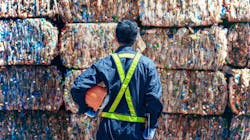Leveraging Artificial Intelligence to Reduce Plastic Waste
Waste pours into the world’s oceans at a rate of 12.7 million tons per year, and much of it is made up of plastics. With 40% of the world’s plastic being used for some kind of packaging, how products are packaged has become an obvious target in protecting the world’s fragile ecosystems. Consumers seem to be mindful of this. Half of UK consumers, for example, would pay more to avoid plastic packaging. Governments are also aware and are cracking down on single-use plastics with a wave of regulatory measures.
But packaging isn’t the only source of plastic waste. Product design is an expensive proposition, and often engineers lack the time or motivation to wring as much waste from their proposed products as possible. Simulations, prototyping and testing, for example, are all vital in bringing reliable, cost-effective products to market. But these processes can be costly, with multiple iterations to streamline the final design, and even the slightest change along the way can require starting over from the top. It’s easy to see how unneeded plastic (waste) can accrue in this painstaking operation.
Product development also involves many prototypes and models to validate performance in testing, another source of plastic waste. The recent pandemic has added to the pile of plastic waste as it drove demand for single-use plastics.
With more than 80% of a product’s environmental impacts determined during the design phase, it becomes obvious any solutions to the plastic waste problem must begin at that phase.
This is where artificial Intelligence (AI) can play a vital role. It can use the huge archives of data generated in the past during product development and manufacturing, analyzing it to identify weaknesses and areas for improvement.
Take the AI behind Amazon’s new packaging. The company used algorithms to learn from real-world customer complaints how to lower the numbered damaged packages while reducing the use of packaging materials. By specifying padded mailers instead of boxes for certain items or deliveries, thousands of Amazon packages become lighter and smaller. This meant more packages can fit on delivery trucks while reducing waste from all angles. This data-driven approach has reduced Amazon’s shipping costs by 5% and lowered the carbon footprint of each item shipped.
AI has also been used to cut waste and cost and reduce the number of wrongly labelled products. Tesco, for example, recently began using made on certain meat products to cut down food waste and excess packaging. The label and date information can be read on packaging lines by existing scanners, preventing errors, emergency product withdrawals and product recalls.Even a process as simple as making a sports water bottle can use AI software to determine the best packaging. It, can analyze variables such as liquid density and material strength, and then suggest a new design or material. AI can then predict the durability and the amount of plastics used. It can even decide if a different strength of various designs with fewer lengthy tests and reduce material could get similar, or better, results. For example, AI solutions can help in switching to “smarter” plastics that last longer and can be easily recycled.
Global beauty brand L’Oréal, for example, is leveraging AI in its effort to ensure all the plastic packaging it uses is either recycled or bio-based by 2030, while curbing its greenhouse gas emissions by 50% per finished product unit. It is using AI-powered predictive tools to accurately estimate the performance of product and packaging designs faster and more accurately. This lets the company reduce the amount of materials needed in making the products and to ensure each product is as sustainable as possible.
AI can also be used to streamline supply chains. Demand forecasting, according to marketing firm Gartner, is the most popular type of AI used in supply chain planning. It is used by 45% of all companies to minimize failures in demand and capacity.
AI can also eliminate some supply-chain problems by predicting consumer demand. A recent report from McKinsey, for example, found that AI-powered forecasting reduces supply-chain errors by 30 to 50%, with a 65% reduction in lost sales due to inventory out-of-stock situations and decreased warehousing costs.
One reason why eco-friendly packaging is slow to enter the market is because a product’s environmental footprint is normally calculated near the end of the manufacturing process. In deciding how the product will be manufactured, the smallest change can have a domino effect on packaging that demands new materials and design variations, as well as rebrandings. In addition, packaging designers must adjust packaging to meet the needs and demands of a range of geographically different markets, creating many variations on the same design. That’s a lot to consider.
AI, however, can help. As well as innovating ways to deal with plastic waste once it already exists, AI can eliminate waste from design processes right from the outset. It can take a deep-dive into difficult engineering data, getting to the root of production relationships to iron out repetitive and wasteful development cycles, nixing the need for multiple variations and arriving at the right packaging design faster than ever before.
So AI can streamline packaging, making that packaging as sustainable as possible. It can also increase the use of biodegradable or recyclable materials, and ensure dimensions and weight are minimized to cut down shipping costs.
To gear up the fight against irresponsible plastic consumption, companies need to fundamentally change the design phase of products to take AI into account. Environmental impact should lie at the core of product design, embedded as a quantifier in various ways (materials and durability). The design phase should also take into account the product’s lifespan, with disposal and recycling in mind from the beginning.
However, this isn’t some dystopian vision of the future where machines largely replace humans. Instead, human teams need to work with AI, building customized processes for lowest costs, shortest times and maximum environmental value.
AI has the power to do much of this, transforming the design process, the manufacturing procedures and supply chain to reducing plastic waste in months rather than decades. Before investing in costly data architecture, however, engineers need to determine how and why they are using current data, and what problems could be fixed with AI. But not all AI is created equal; it’s also important that engineers and managers identify the right type of AI that fits their challenges and will deliver the most effectiveness and scalability.
Richard Ahlefeld is founder and CEO of Monolith.


